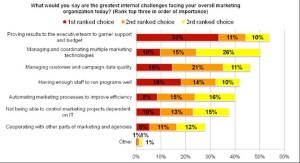Industry experts report that marketers this year will spend $171 billion on paid advertising. Those advertisers, and their bosses, will experience much anxiety because in many cases they won’t know what worked and/or how well it worked. Here’s a quote from a famous man that underscores this -

It’s a marketer’s biggest challenge
In our marketing practice we speak with companies all the time that express concerns about the productivity of their marketing investments. It’s common to hear, “last year I spent $50,000 and I don’t really know what I got from it.” In fact, marketers indicate “proving results to the executive team to garner support and budget” is the biggest challenge they have (see chart below).
Get to “marketing enlightenment”
Imagine for a moment your ability to know what your goal attainment and return on investment are for each of your various online marketing investments (and some offline) – that would be amazing, right? You’d be able to shift money from one tactic to another to maximize your results. You’d be a very enlightened and successful marketer.
With a little creative thinking, the right resources and someone who can configure web analytics data, you can get to that stage of “marketing enlightenment”. Here’s a 3-step process to achieve “marketing enlightenment” and uncover your Return-on-Marketing-Investment (ROMI).
Step 1 – Identify your micro and macro goals
Think about what you want your customers to do as a result of your marketing efforts – what actions you want them to take. Some ideas about this might include
- They call you or they come into your place of business
- They go to your website to download some information, join a mailing list, sign up for a service, purchase something, etc.
- They go to your website and view a product page or some other item that indicates they are a interested customer
- They click on a link in your e-newsletter that leads them back to your website
- They share a social media post
- They go to your website from a print ad or they call-in from a radio commercial
You get the idea. Just think about two things here: 1) what actions you want your customers to take (macro goals), and 2) what actions your customers take that indicate they are a good potential customer (micro goals). The micro goals are small but important because they help you measure the effectiveness of your various marketing activities and channels.
Step 2 – Set up ways to track your goals
Once you’ve identify your micro and macro goals, now you have to establish ways to track them. Here are some thoughts about doing that…
- Install landing pages and/or obtain vanity URL’s – these can be used in print campaigns such as newspaper, direct mail, etc., and some broadcast and online campaigns. By using a landing page and/or vanity URL, you can track how many people came to your website from various marketing tactics.
- Call tracking #’s – obtain some unique phone numbers and attribute them to your various ad campaigns. That way you can track how many phone calls you got from each of your marketing campaigns.
- Configure marketing segments in your web analytics – make sure your web analytics software is tracking marketing channels and/or customer types. By setting up channel and/or customer segments, you can measure attainment of micro and macro goals by channel.
- Configure micro and macro goals in your web analytics - configure your micro and macro goals in your web analytics software. When you combine information from your various marketing channels (#3 above) with attainment of micro and macro goals, you’ll be amazed at how much you’ll learn about where to invest your marketing budgets.
Step 3 – Track and allocate your marketing budgets
You’ve got your macro and micro goals established and you have tracking mechanisms in place to see how they are doing. Now begin calculating your “conversion rates” – i.e. the rate at which your customers are taking the actions you want them to take. Measure your conversion goals by marketing campaign. For example, you might find that your cost-per-lead from paid search marketing is better than that of social media. If so, move money from social media to do more paid search. You may find that more people go to your landing page or call your tracking phone number from radio than from a newspaper ad. If so, move newspaper money to radio.
In summary, decide what actions you want your customers to take from your marketing activities. Put tracking mechanisms in place – phone tracking, landing pages and/or vanity URL’s, and web analytics configurations – to capture their actions. Then, evaluate the data and move your online marketing budgets around to maximize overall results.
This might seem to some like a lot of work. However, we’ve done this many times for clients and what you learn is both amazing and profitable – and in nearly all cases, very much worth the work.






Agree, disagree, or just have something to add?
Leave a comment below.